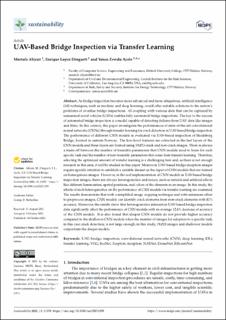Uav-based bridge inspection via transfer learning
Peer reviewed, Journal article
Published version
Date
2021-10-14Metadata
Show full item recordCollections
Abstract
As bridge inspection becomes more advanced and more ubiquitous, artificial intelligence (AI) techniques, such as machine and deep learning, could offer suitable solutions to the nation’s problems of overdue bridge inspections. AI coupling with various data that can be captured by unmanned aerial vehicles (UAVs) enables fully automated bridge inspections. The key to the success of automated bridge inspection is a model capable of detecting failures from UAV data like images and films. In this context, this paper investigates the performances of state-of-the-art convolutional neural networks (CNNs) through transfer learning for crack detection in UAV-based bridge inspection. The performance of different CNN models is evaluated via UAV-based inspection of Skodsberg Bridge, located in eastern Norway. The low-level features are extracted in the last layers of the CNN models and these layers are trained using 19,023 crack and non-crack images. There is always a trade-off between the number of trainable parameters that CNN models need to learn for each specific task and the number of non-trainable parameters that come from transfer learning. Therefore, selecting the optimized amount of transfer learning is a challenging task and, as there is not enough research in this area, it will be studied in this paper. Moreover, UAV-based bridge inception images require specific attention to establish a suitable dataset as the input of CNN models that are trained on homogenous images. However, in the real implementation of CNN models in UAV-based bridge inspection images, there are always heterogeneities and noises, such as natural and artificial effects like different luminosities, spatial positions, and colors of the elements in an image. In this study, the effects of such heterogeneities on the performance of CNN models via transfer learning are examined. The results demonstrate that with a simplified image cropping technique and with minimum effort to preprocess images, CNN models can identify crack elements from non-crack elements with 81% accuracy. Moreover, the results show that heterogeneities inherent in UAV-based bridge inspection data significantly affect the performance of CNN models with an average 32.6% decrease of accuracy of the CNN models. It is also found that deeper CNN models do not provide higher accuracy compared to the shallower CNN models when the number of images for adoption to a specific task, in this case crack detection, is not large enough; in this study, 19,023 images and shallower models outperform the deeper models.

